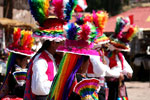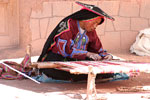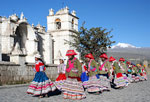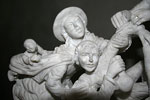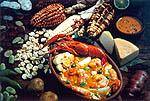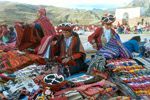Peru a Living Culture
Peru Live the Legend!
Travelers who visit Peru will discover that, as in very few places in the world, its past, present and future live in harmony. Ancestral civilizations, such as the ancient inhabitants of Machu Picchu, go hand in hand with the attractions of cosmopolitan Lima. However, the tourists who visit us will easily find out that, of all these wonders, the pulse of the present is contributed by our people, our mixture of races, traditions and festivals, making Peru a country more alive than ever.
Peru's distinguishing seal is its living culture, an experience you definitely cannot miss out on. Whether it is about participating in ancient rituals, like an offering to the earth, or working in the fields next to farmers, forming part of the parades during one of the many festivals, riding a Peruvian paso horse, or learning to dance to Afro-Peruvian or Andean music, go ahead and do it because it is going to make you feel more like home.
Peru offers excellent destinations to found a Living Culture
Prepare to surrender to its magic. The celebration of almost 3.000 popular feasts per year is but one small hint of the vast treasure trove of multicultural traditions you will find here.
From the coast to the jungle and through the highlands, Peruvian people live the same way as their ancestors did a thousand years ago; maintaining their dances, handcrafts, textiles, customs and keeping their spirit alive.
At Titicaca, the highest navigable lake in the world, a whole village floats on the water. Hundreds of the years ago the Uros people created these floating islands - made of Totora reed - by stacking one reed on top of another until a stable platform was built. They lived on these islands as they sailed around the lake to fish or hunt for their food. You can still see the Uros today, living as if they had floated through time.
Conscious of the value that living cultures mean to travelers from every corner of the world, a number of communities in Puno have opened to rural and experienced based tourism, both in the island and on land. It is there were the ventures of Taquile, Amantani, Uros and Llachon can be found. The visitor to Amantani or Taquile islands will visit Uros island on the route.
"Qoyllur Rit'i "- the feast of the Shining Snow - is one of Peru's most incredible expressions of faith and tradition. Starting on Trinity Sunday, more than 70.000 people come together at the Sinakara Valley in the province of Quispicanchis, Cuzco, to embark on a pilgrimage of hope to the top of a snow covered mountain, 15.090 feet above sea level. After a 5 mile walk, thousands of dancers, hundreds of bands and countless believers finish their journey toward the "Apus" -the mountain gods- asking for money, love, luck, or whatever else they feel they are lacking.
Most of these people will speak Quechua -the mother-tongue of more than 3 million Peruvians- or any of the 91 other indigenous languages that are still in use. Aguaruna, Machiguenga and Huitoto are just some of the native tongues that survive in the jungle, keeping the voices of our forefathers intact, along with their customs.
Almost all of the native handcrafts you'll see are made of natural elements like bones, feathers and seeds that are collected to create beautiful pieces of art.
Medicine here is based on the use of plants and herbs that have been used for hundreds of years. This practice is so widespread, Peru's Ministry of Health has an office dedicated to it.
Venture up into the highland and through the Andes, and you will find that the remains of the Incas are all around. Whether you're walking through the stone roads of the Inca Trail - built 500 years ago but still in use today- or viewing the innovative "andenes" -terrace farming- you'll witness how the present meets the past.
Folk and Art in Peru
Peru boasts one of the largest varieties of arts and crafts on Earth. The diversity, color, creativity and multiple functions of Peru's folk art has made it a fundamental activity not just for Peru's cultural identity, but also as a way of life for thousands of families and even entire communities.
Festivals and Rituals in Peru
Peru celebrates some 3.000 festivals a year. Most of them are held in homage to a patron saint and are part of the Christian calendar adopted in colonial times, although they have blended with the magical beliefs of ancient forms of worship.
Traditional Dress in Peru
In Peru's rural areas, the way people dress makes an important distinction, as a result of the blend of pre-Hispanic influences with the European clothing that the natives were forced to wear during the colonial era.
Music and Dances in Peru
Thanks to the recent archaeological discoveries of musical instruments, experts now know that in Peru, music has been played at least as far back as 10.000 years ago.
Peruvian Cuisine
Peru it is a pleasure
With a mixture of cultures, our identity is enriched by a great diversity of flavors. Peruvian cuisine is the result of experience, fusion and our genuine hospitality, of the satisfaction of witnessing how visitors enjoy good cooking. The marine riches of our seashore, the harmony of the Andes and the mystery of the jungle become textures, colors and delicious aromas that turn Peru into a feast of flavors. Proposed and are under evaluation by UNESCO as intangible cultural heritage (2011).
Rural Tourism
New tendencies are beginning to emerge in today's world, in which a new type of traveler has appeared; a traveler in search of a different experience, less massive, and with better contact with rural societies. For those communities that have started taking some initiatives in order to incorporate themselves into the most consolidated tourist circuits of Peru, a wonderful economic alternative of development has presented, and rural communal tourism has the potential to become one of the most efficient mediums through which to improve the quality of life of the most excluded towns in Peru.
Discover it all for yourself.
Come to Peru!
Where you'll experience all these archaeological monuments, along with the remains of an ancient culture that's still very much alive.
Peru a Living Culture E-Guides |
|
 |
|

